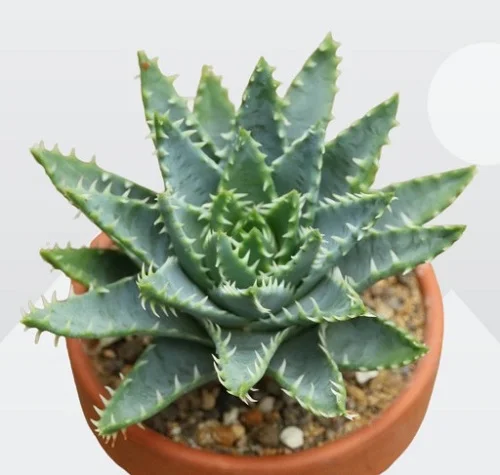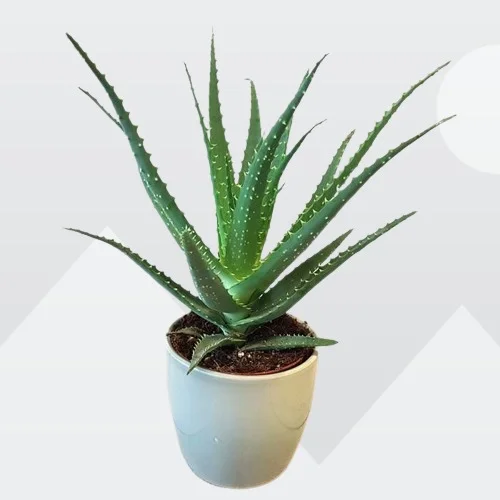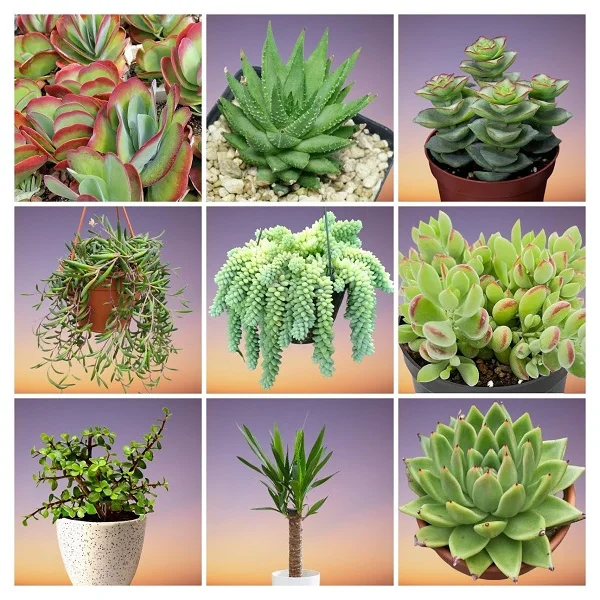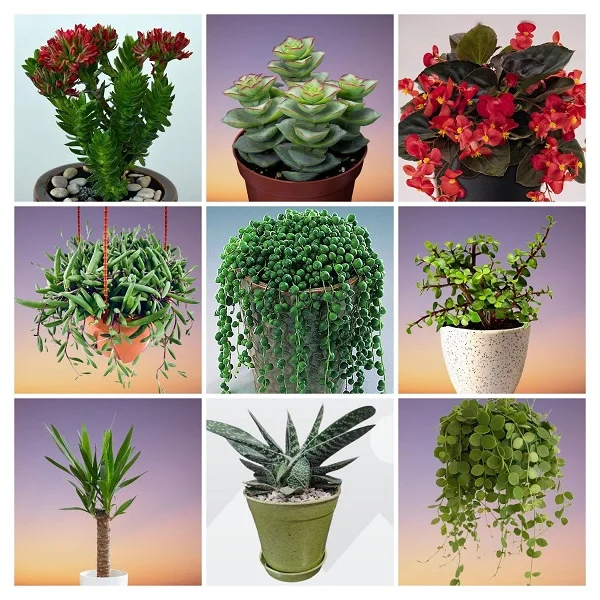Aloe Plants Indoor Care, Propagation, Growing Problems and Solutions
Some links in this post may be affiliate links
Aloe Plants blossom in bright light with some direct sunlight, average warmth, moderate humidity and moderately moist, rich, well-drained, succulents potting mix coupled with monthly feeding in the growing season.
Aloe Plants are among the popular succulent plants grown in the home space. They come in all shapes and sizes. There are numerous species of Aloes but only a few are popular for home growing.
Aloes form a stemless rosettes of fleshy (succulent) leaves which store water and allows these plants to survive well in drought conditions. These characteristics, make Aloes some of the best drought-tolerant plants that you can grow in the home.
The flowers in Aloes are tubular, frequently yellow, orange, pink or red and are borne , densely clustered and pendant at the apex of simple or branched leafless stems.
Aloe reproduce by means of offsets (pups) which form at the base of the plant once the plant has reached maturity.

Aloe brevifolia
Botanical name: Aloe
Family: Asphodelaceae
Subfamily: Asphodeloideae
Origin
The Aloe genus is native to tropical and southern Africa, Madagascar, Jordan, the Arabian Penisula and various islands in the Indian Ocean.
Varieties
There are over 560 species in the Aloe genus. The most popular species of Aloe Plants is Aloe barbadensis, the Aloe vera or "true aloe". Other popular species are Aloe aristata (Lace Aloe), Aloe variegata (Partridge-breasted Aloe), Aloe jucunda, Aloe humilis (Hedgehog Aloe) and Aloe mitriformis among many others. Check out these 15 Aloe succulent plants for home growing.
Toxicity
Aloe Plants are non-toxic to humans and toxic to pets as indicated by ASPCA. If ingested they can cause vomiting, diarrhea and lethargy in pets.
Related Plants
Aloes are closely related to the genera Haworthia and Gasteria. The species of these genera are known to hybridise relatively easily with each other.
Where to Buy
Aloe Plants are pleasant plants to add to your plant collection as they are easy to grow and maintain. They are available online on Amazon (Link to Amazon).
Aloe Plants Care Indoors
Aloe Plants blossom in bright light with 6-8 hours of direct sunlight, average warmth of 16-280C, moderate humidity of 50-55% and moderately moist, rich, well-drained, succulents potting soil coupled with monthly feeding during the growing season.
Aloes need repotting is only needed when the plant becomes pot-bound. Pruning is necessary to keep the plant neat as well as discourage pest and disease infestations. Keep reading for more on these growing conditions and how to achieve them.

Aloe arborescens
Watering
Water Aloe Plants thoroughly during the growing season and allow the top 2-3 inches of soil to dry out between waterings.
Decrease watering during the cold period to maintain the soil barely moist but do let it dry out completely.
Avoiding wetting the center of the rosette as it can lead to rotting. Water the Aloe from the bottom instead.
Water the Aloe with room temperature water to avoid plant shock. Avoid soggy soil as it can lead to rotting. Read more on how to water houseplants the right way.
Light Requirements
Aloe Plants grow best under bright light with 6-8 hours of direct sunlight. Avoid exposing the plants to too hot sunlight before acclimatizing them as they can get sun scorched.
Rotate the pot regularly to ensure that the plant receives light on all sides for uniform growth.
Aloes will also grow under a grow light where the natural lighting is not sufficient. Check out these full spectrum grow lights on Amazon.
Temperature and Humidity
Average warmth between 16-280C during the growing season is ideal for Aloe Plant. Keep it away from cold drafts as they can cause browning and leaf drop.
Aloes have no need for extra humidity. Average room humidity of 50-55% is ideal for these plants. However, make sure that there is good air circulation to prevent fungal diseases infestations.
Potting Mix
The best soil for Aloe Plants should be rich in organic matter, loose and free-draining to avoid getting soggy soil. The soil should be loose enough to allow water to drain out fast enough.
Cactus and succulents mixes are perfect for Aloes. Check out these
Fertilizer
Feed Aloe Plants every 4 weeks during the growing season with a succulents fertilizer. Do not feed during the cold period as growth is minimal at this time. Read more on how to feed houseplants.
Repotting
Aloe Plants have a small root system so frequent repotting is not necessary. Repot the plant at the beginning of the growing season only when it becomes crowded in its current pot.
Repot the Aloe into a pot 1 size larger and one that has a drainage hole to prevent soggy soil as it can lead to rotting. Use a shallow pot and be careful not to bury the stems to prevent rotting. Take a look at these ceramic succulents pots with drainage holes on Amazon.
Pruning
Pruning Aloe Plants is easy. Cut the dead or diseased leaves with a sharp knife to keep the plant neat and to reduce pests and disease infestation.
Propagation
Aloe Plants propagation can be done at the beginning of the growing season from offsets (pups) which form at the base of the plant.
How to propagate Aloes from offsets
Carefully seperate the offsets from the mother Aloe Plant. Allow the offsets to dry (callus) for 1-3 days before potting to prevent rotting. Select an offset that has several leaves.
Pot each offset in its individual pot in moist, free-draining soil.
Water sparingly, only when the soil is dry and avoid soggy soil as it can lead to rotting.
Allow the Aloe to be well established after which you can begin routine care.

Aloe bakeri
Aloe Plants Growing Problems
Aloe Plants problems are mainly due to cultural faults in watering and include brown leaf tips, leaf spots, wilting, rotting, shrivelled leaves, pests and diseases among others. Read on for more on these problems, their remedies and solutions.
Brown soft spots
Brown soft spots in Aloe Plant is an indication of leaf spot disease which is brought about by over wet conditions coupled with poor air circulation.
Avoid wetting the rosette of leaves. Make sure that the pot has a drainage hole and the soil is loose and free-draining to prevent it from getting soggy.
Improve on ventilation and ensure that there is free air circulation. Read more on how to treat leaf spot disease in houseplants.
Rotting base, yellowing and shrivelled leaves
Rotting base, yellowing and shrivelled leaves in Aloe Plant is an indication of crown and stem rot disease which is brought about by overwet conditions.
Ensure that the pot has a drainage hole and the soil is loose and free-draining to prevent it from staying too wet.
Avoid wetting the rosette of leaves and water from the bottom instead. Read more on how to treat crown and stem rot disease in houseplants.
Pests
Aloe Plants are fairly resistant to pests but weak plants can be attacked by mealy bugs, scale insects and spider mites. Regularly inspect the plant for pests and carry out timely control. Read on how to identify and get rid of pests in houseplants.
Brown leaf tips
Brown leaf tips in Aloe Plant are caused by underwatering during the growing season as it requires the soil to be moderately moist through out.
Water the plant liberally during the growing season while allowing the top 2-3 inches of soil to dry out between waterings but do not allow the soil to dry out completely.
Wilted and discolored leaves
Wilted and discolored leaves in Aloe Plant are due to overwatering during the cold period. Growth is minimal at this time therefore the plant does not require much water.
Significantly reduce watering in the cold season to maintain the soil barely moist. Do not wet the soil thoroughly during this period and also ensure that the pot has a drainage hole to prevent the soil staying too wet.
You liked it? Share on social media.
Related Content
Amazon Associates Disclosure
Homeplantsguide.com is a participant in the Amazon Services LLC Associates Program, an affiliate advertising program designed to provide a means for sites to earn advertising fees by advertising and linking to amazon.com.





